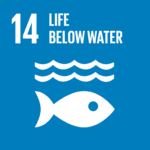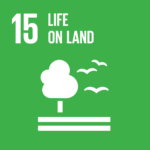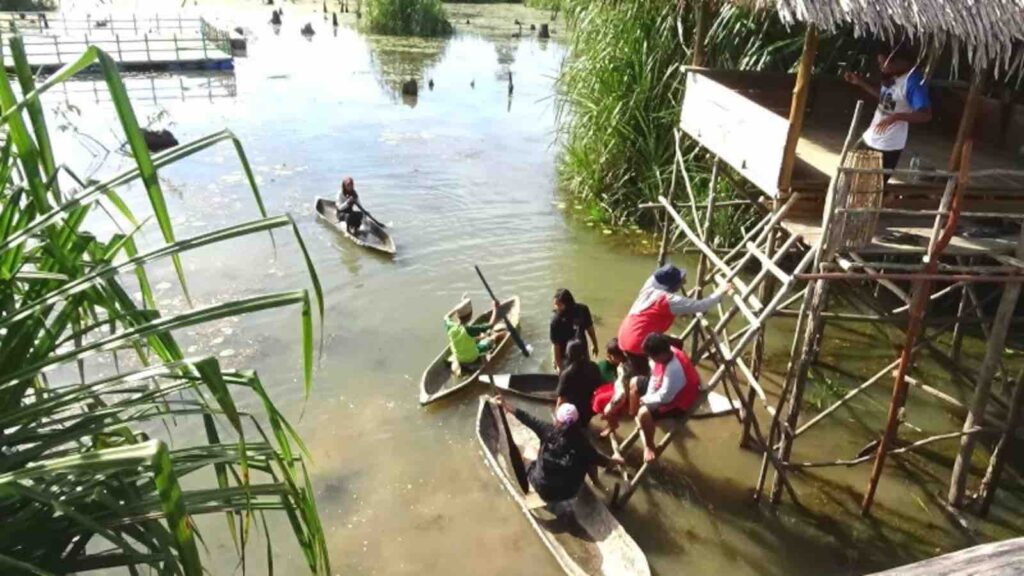Spanning approximately 8,040 hectares, Tebat Rasau is the headwaters of the Lenggang – the longest river on Belitung Island and the Lanun Community is committed to safeguarding the Lenggang River.
In the village of Lintang, East Belitung Regency, Bangka Belitung Islands Province, Nasidi and his community are steadfast custodians of an ancient waterway – the Lenggang River, formed during the mid-Cenozoic era around 65 million years ago.
RELEVANT SUSTAINABLE GOALS




The river area, lined with pandan trees called rasau, is known as Tebat Rasau. In the local Belitong Malay language, tebat means “water dam,” while rasau refers to the pandan plant. Thus, the name signifies a water reservoir formed by rows of pandan trees.
Spanning approximately 8,040 hectares, Tebat Rasau is the headwaters of the Lenggang – the longest river on Belitung Island at 60.28 kilometers and widest, ranging from 230 to 1,520 meters across. It empties directly into the Karimata Strait.
We do not hesitate to apprehend illegal loggers, tin miners, and those using electricity or poison for fishing,
The head of the Tebat Rasau Indigenous Community
The Lanun Community
The Lanun Community is committed to safeguarding the Lenggang River and its environment from the threats of rampant tin mining and encroaching extractive industries.
Nasidi paddled a small wooden boat through the pandan tree rows lining the ancient Lenggang River in Lintang. “Nine tributaries have already vanished,” he lamented. Nasidi, the Lanun Community, and Lintang villagers are determined to defend the river from destruction. This spirit of resistance inspired him to establish the Lanun Community – lanun means pirate.
“We do not hesitate to apprehend illegal loggers, tin miners, and those using electricity or poison for fishing,” said the head of the Tebat Rasau Indigenous Community. Prior to 2000, residents easily caught the prized Asian arowana in the Lenggang. But when palm plantations arrived in 2013, conditions changed. Devastating floods in 2017 became a tipping point, leaving no room for extractive companies.
“In the past, when it rained upstream, it would take three days for the water to reach our village. Now, it arrives rapidly, causing floods,” Nasidi recounted.
An unforgettable incident occurred on August 17, 2016, when Lintang villagers discovered 30 hectares of their forest cleared by heavy machinery. To this day, they continue fighting to protect 3,800 hectares from industrial plantation firms.
Their efforts span demonstrations, advocacy, and mediation across various parties. “We raised funds from fellow residents to fight against forestry companies encroaching on our lands,” said Nasidi. His father Samian supported the struggle, even selling his own land.
“If we didn’t stop them, our village would be gone,” Nasidi explained. Before him, Hariyanto spearheaded efforts to save Lintang’s river and forests since the 1990s; he now farms pepper.

“We once guarded the forest for seven months through rotating ‘pagar betis’ vigilance, with 50-60 people on watch daily. Residents want the area designated as a social forestry scheme, not an industrial plantation,” Hariyanto recounted.
As palm and tin mines proliferated, villagers’ river-based livelihoods declined. Previously, fishing simply required angling or setting traditional siro traps three times yearly, some 2×2 or 2×3 meters in size.
“Using siro, we could catch 3-4 tons of fish annually,” he added.
Sandi, a former Lintang tin miner, said illegal miners often dredged riverbanks, dumping waste indiscriminately to pollute waters and accelerate siltation.
“Eight years ago, tin fetched Rp20,000 per kilogram. Now it’s around Rp130,000 per kilogram,” he noted. Mining income was erratic, sometimes earning 20-30 kilograms daily among two or three workers.
“Today I work in wood processing,” Nasidi shared.
Geosite Tebat Rasau Ecotourism to Boost Local Economy
Boosting the local economy, an ecotourism venture called Geosite Tebat Rasau showcases the area’s natural splendor and endemic fish habitats like the Asian arowana, emperor snakehead, and green spotted puffer.
Established on January 17, 2018, concurrent with the Lanun Community’s official recognition, Tebat Rasau gained Geosite status within the Belitong UNESCO Global Geopark in 2021.
“We had to create something the government would recognize,” said Nasidi of the longstanding Lanun group. From October-November 2023, nine students joined a cultural youth camp facilitated by the Education and Culture Ministry in Tebat Rasau for a month, mapping the village’s cultural, small business, and flora-fauna potential. They created kbkmdesalintang.info, a site with village information.
After the program, they entered Ashoka’s 2024 Gaharu Bumi Innovation Challenge under Lanun Muda in the community category, making the top 12.
“We need to introduce Tebat Rasau,” said Teknik Geofisika student Bimo Rangga Alfaroby Masyafwa from Institut Teknologi Sepuluh Nopember, who joined the camp.
Nasidi added that ecotourism aims to protect nature and preserve the Lenggang River with its biodiversity. From 2020-2023, Tebat Rasau welcomed 30 international tourists, 330 domestic visitors, and 1,047 local guests.
“Our forest’s lifeblood is the Lenggang River,” he affirmed.
Lead image courtesy of KlikNusae/Adhi
You may also be interested in :
World Wetlands Day 2024: Protect Wetlands For Ecological Stability and Human Prosperity


